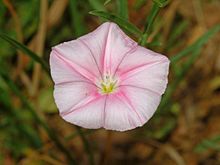- Convolvulus cantabrica
-
Convolvulus cantabrica Scientific classification Kingdom: Plantae (unranked): Angiosperms (unranked): Eudicots (unranked): Asterids Order: Solanales Family: Convolvulaceae Genus: Convolvulus Species: C. cantabrica Binomial name Convolvulus cantabrica
L.Synonyms - Convolvulus cardiosepalus Boiss.
- Convolvulus dorycnioides De Not. [1]
Convolvulus cantabrica, common name Cantabrican Morning Glory or Dwarf morning glory, is a herbaceous perennial plant belonging to the genus Convolvulus of the Convolvulaceae family.
Contents
Description
This bindweed is a hemicryptophyte scapose plant reaching on average 20–50 centimetres (7.9–20 in) in height. It has simple, alternate, lanceolate leaves, coarsely hairy on both sides. The wide funnel-shaped flowers are actinomorphic ("star shaped", "radial") and arranged on a long petiole at the leaf axils. The corolla is 15-25 mm long and usually pale pink, but it can be completely white. The flowers are hermaphrodite and pollinated by insects (entomogamy). The flowering period extends from May through October. The fruits are globose and pubescent capsules with 2-4 brownish seeds.
Gallery
Distribution
This species is native to southern Europe and widespread in the Mediterranean coasts.
Habitat
Convolvulus cantabrica prefers rocky places, sunny slopes, xerophilous prairies, dry grassland and scrublands with calcareous soil, at an altitude of 0–1,300 metres (0–4,300 ft) above sea level.
References
- Pignatti S. - Flora d'Italia – Edagricole – 1982. Vol. II, pag. 387
- Acta Plantarum
- Flora.uniud.it
External Links

This Solanales article is a stub. You can help Wikipedia by expanding it.





